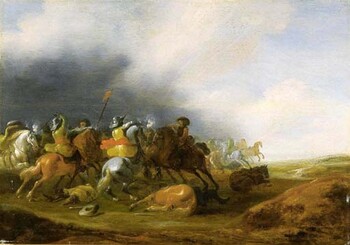Jan Jacobsz. van der Stoffe
Cavalry skirmish
Oil on panel : 37,2 X 49,2 cm
Signed bottom right “J.V.D. Stoffe”
Leiden, Museum De Lakenhal
This is a comparative item

Painting for Sale
Stoffe, Jan Jacobsz. van der
"One of a pair of cavalry battle scenes"
In short
Van der Stoffe was one of the main Dutch battle scene painters in the last decade of the Eighty Years’ War, which ended in 1648 with the final recognition by Spain of an independant Dutch Republic.
Our paintings are early works, showing the influence of Palamedes Palamedesz. . One them is fully signed and dated “1640”.
About Jan Jacobsz. van der Stoffe
Dutch painter
Leiden circa 1610/11 – 1682 Leiden
Van der Stoffe is documented in Leiden between 1644, when he became member of the Painters’ Guild, and his death. In 1669 he was dean of that Guild.
His earliest painting dates from 1635.
Stylistically he stood very close to Abraham van der Hoef (Haarlem 1611/12 – 1666 Haarlem). Van der Stoffe and van der Hoef are considered as the most important Dutch battle scene painters of the last decade of the Eighty Years War, which ended in 1648, with the Peace of Westphalia. It sealed the recognition by Spain of an independent Dutch Republic. Both specialists depicted the intensity of battles with a lot of detailed precision.
About our pair of paintings
Most of van der Stoffe’s battle scenes are not signed and just a few of them are dated. One of our paintings is signed and dated “1640”.
In his early years our painter was influenced by Palamedes Palamedesz. (1607 – 1638), who was active in Delft. The “z.” in his last name is an abbreviation for “zoon”, therefore his last name should be read as Palamedeszoon, meaning “son of Palamedes”. In the same manner our painter’s second first name, Jacobsz. should be pronounced “Jacobszoon”.
Circa 1635 Palamedesz. had reduced the size of the heads of his horses, and he painted these onto broad necks. Van der Stoffe has followed this example.
Military uniforms only appeared towards the end of the 17th century. Sixteenth and seventeenth century soldiers recognized each other by colours: orange (sometimes also blue or black) for the Dutch, red for the Spanish. During the Eighty Years’ War foreign troops joined the Spanish or the Dutch side for religious or for political reasons, but finally also just for the money, as mercenaries :
- the Spaniards used Flemish, Walloon, German and even Croatian soldiers;
- the Dutch were helped by French, Irish, Scottish, English and Swedish troops.
The colours appeared in sashes, worn round the middle, and in plumes, attached to the hats and helmets. Here, the Dutch cavalrymen, wearing orange, are clearly beating their enemies.
Why should you buy this painting?
Because a signed pair of battle scene paintings representing the Eighty Year’s War is extremely rare.
Comparative paintings
Click photos for more details









